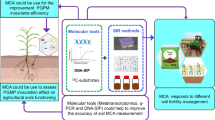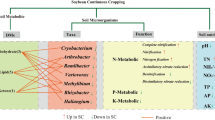Abstract
Microcalorimetry and BIOLOG are common tools in the study of soil microbial metabolism. When used combined, they may reveal further details about soil microbial metabolic diversity than individually. Through this study, we demonstrated the advantages of such a combinatorial methodology by comparing soil samples from two locations in China, each with (OM samples) and without (control) organic fertilization. We used BIOLOG and microcalorimetry to study soil microbes’ ability to metabolize different C substrates. Microcalorimetric measurements helped us further reveal the differences in the microbial growth kinetics under different BIOLOG-identified C substrates. Results showed that soils differed in the preferred C substrates, as denoted by the thermodynamic parameters. Some C substrates stimulated the active microbial biomass, while some stimulated microbial growth rate. Most interestingly, certain C substrates (e.g., l-arginine for Shandong soil and glycogen for Henan soil) showed stimulating effects on both OM and control soils, which could be attributed to the pH value and P availability in soil. Hence, we believe microcalorimetry could be potentially used to explore the soil microbial metabolic diversity by combining BIOLOG measurement, especially in determining how microbes assimilate different nutrient sources.


Similar content being viewed by others
References
Zhang Q-C, Shamsi IH, Xu D-T, Wang G-H, Lin X-Y, Jilani G, et al. Chemical fertilizer and organic manure inputs in soil exhibit a vice versa pattern of microbial community structure. Appl Soil Ecol. 2012;57:1–8.
Nannipieri P, Ascher J, Ceccherini MT, Landi L, Pietramellara G, Renella G. Microbial diversity and soil functions. Eur J Soil Sci. 2003;54(4):655–70.
Garland JL. Analytical approaches to the characterization of samples of microbial communities using patterns of potential C source utilization. Soil Biol Biochem. 1996;28(2):213–21.
Alden L, Demoling F, Baath E. Rapid method of determining factors limiting bacterial growth in soil. Appl Environ Microbiol. 2001;67(4):1830–8.
Islam MR, Chauhan PS, Kim Y, Kim M, Sa T. Community level functional diversity and enzyme activities in paddy soils under different long-term fertilizer management practices. Biol Fertil Soils. 2011;47(5):599–604.
Gomez E, Garland JL. Effects of tillage and fertilization on physiological profiles of soil microbial communities. Appl Soil Ecol. 2012;61:327–32.
Prado AGS, Evangelista SM, SouzaDe JR, Matos JGS, Souza MAA, Oliveira DA, et al. Effect of the irrigation with residual wastewaters on microbial soil activity of the ornamental flowers (Dahlia pinnata) cultures monitored by isothermal calorimetry. J Therm Anal Calorim. 2011;106(2):431–6.
Vazquez C, Lago N, Mato MM, Esarte L, Legido JL. Study of the growth of Enterococcus faecalis, Escherichia coli and their mixtures by microcalorimetry. J Therm Anal Calorim. 2016;125(2):739–44.
Braissant O, Bonkat G, Wirz D, Bachmann A. Microbial growth and isothermal microcalorimetry: growth models and their application to microcalorimetric data. Thermochim Acta. 2013;555:64–71.
Rong X-M, Huang Q-Y, Jiang D-H, Cai P, Liang W. Isothermal microcalorimetry: a review of applications in soil and environmental sciences. Pedosphere. 2007;17(2):137–45.
Braissant O, Wirz D, Gopfert B, Daniels AU. Use of isothermal microcalorimetry to monitor microbial activities. FEMS Microbiol Lett. 2010;303(1):1–8.
Wu M, Qu F, Zhao Y, Wang J, Su H, Chen C, et al. Microcalorimetry and turbidimetry to investigate the anti-bacterial activities of five fractions from the leaves of Dracontomelon dao on P aeruginosa. J Therm Anal Calorim. 2016;123(3):2367–76.
Wadso I. Isothermal microcalorimetry in applied biology. Thermochim Acta. 2002;394(1–2):305–11.
Wadso I. Characterization of microbial activity in soil by use of isothermal microcalorimetry. J Therm Anal Calorim. 2009;95(3):843–50.
Harris JA, Ritz K, Coucheney E, Grice SM, Lerch TZ, Pawlett M, et al. The thermodynamic efficiency of soil microbial communities subject to long-term stress is lower than those under conventional input regimes. Soil Biol Biochem. 2012;47:149–57.
Xu J, Feng Y, Wang Y, Luo X, Tang J, Lin X. The foliar spray of Rhodopseudomonas palustris grown under Stevia residue extract promotes plant growth via changing soil microbial community. J Soils Sediments. 2016;16(3):916–23.
Xu J, Feng Y, Wang Y, Wang J, He X, Lin X. Soil microbial mechanisms of Stevia rebaudiana (Bertoni) residue returning increasing crop yield and quality. Biol Fertil Soils. 2013;49(7):839–46.
Meng L, Ding WX, Cai ZC. Long-term application of organic manure and nitrogen fertilizer on N2O emissions, soil quality and crop production in a sandy loam soil. Soil Biol Biochem. 2005;37(11):2037–45.
Mebius LJ. A rapid method for determination of organic carbon in soil. Anal Chim Acta. 1960;22:120–4.
Bremner JM. Total nitrogen. In: Black CA, Evans DD, Ensminger LE, White JL, Clark FE, Dinauer RC, editors. Methods of soil analysis, Part 2. Chemical and microbiological properties. Madison, WI: American Society of Agronomy Inc; 1965. p. 1149–78.
Olsen SR, Cole CV, Watanabe FS, Dean LA. Estimation of available phosphorus in soils by extraction with sodium bicarbonate. Washington, DC: United States Department of Agriculture; 1954.
Zak JC, Willig MR, Moorhead DL, Wildman HG. Functional diversity of microbial communities: quantitative approach. Soil Biol Biochem. 1994;26:1101–8.
Staddon WJ, Duchesne LC, Trevors JT. Impact of clear cutting and prescribed burning on microbial diversity and community structure in Jack pine (Pinus banksiana Lamb) clear-cut using Biolog Gram-negative microplates. World J Microbiol Biotechnol. 1998;14:119–23.
Garland JL, Mills AL. Classification and characterization of heterotrophic microbial communities on the basis of patterns of community-level-sole-carbon-source utilization. Appl Environ Microbiol. 1991;57:2351–9.
Zheng S, Hu J, Chen K, Yao J, Yu Z, Lin X. Soil microbial activity measured by microcalorimetry in response to long-term fertilization regimes and available phosphorous on heat evolution. Soil Biol Biochem. 2009;41(10):2094–9.
Sesto-Cabral M, Sigstad E. A new approach to determine soil microbial biomass by calorimetry. J Therm Anal Calorim. 2011;104:23–9.
Sparling G. Estimation of microbial biomass and activity in soil using microcalorimetry. Eur J Soil Sci. 1983;34:381–90.
Banning NC, Lalor BM, Cookson WR, Grigg AH, Murphy DV. Analysis of soil microbial community level physiological profiles in native and post-mining rehabilitation forest: which substrates discriminate? Appl Soil Ecol. 2012;56:27–34.
Hu J, Lin X, Wang J, Dai J, Chen R, Zhang J, et al. Microbial functional diversity, metabolic quotient, and invertase activity of a sandy loam soil as affected by long-term application of organic amendment and mineral fertilizer. J Soils Sediments. 2011;11(2):271–80.
Chocano C, Garcia C, Gonzalez D, de Aguilar JM, Hernandez T. Organic plum cultivation in the Mediterranean region: the medium-term effect of five different organic soil management practices on crop production and microbiological soil quality. Agric Ecosyst Environ. 2016;221:60–70.
Wakelin SA, Macdonald LM, Rogers SL, Gregg AL, Bolger TP, Baldock JA. Habitat selective factors influencing the structural composition and functional capacity of microbial communities in agricultural soils. Soil Biol Biochem. 2008;40(3):803–13.
Chen R, Hu J, Dittert K, Wang J, Zhang J, Lin X. Soil total nitrogen and natural 15nitrogen in response to long-term fertilizer management of a maize-wheat cropping system in northern China. Commun Soil Sci Plant Anal. 2011;42(3):322–31.
Zhou Y, Pijuan M, Zeng RJ, Lu H, Yuan Z. Could polyphosphate-accumulating organisms (PAOs) be glycogen-accumulating organisms (GAOs)? Water Res. 2008;42(10–11):2361–8.
Schuler AJ, Jenkins D. Enhanced biological phosphorus removal from wastewater by biomass with different phosphorus contents, Part I: experimental results and comparison with metabolic models. Water Environ Res. 2003;75(6):485–98.
Acknowledgements
This work was supported jointly by National Natural Science Foundation of China (Grants Nos. 41501264, 41271256 and 41371253), Natural Science Foundation of Jiangsu Province (BK20140991), CAS Strategic Priority Research Program Grant (XDB15020103 and XDB15010103), the Research Fund of State Key Laboratory of Soil and Sustainable Agriculture, Institute of Soil Science, Chinese Academy of Science (Y412201441), and Startup Foundation for Advanced Talents of Nanjing University of Information Science and Technology (NUIST) and the foundation from China Scholarship Council. It was also developed in collaboration with the University of Santiago de Compostela (Spain) by the project of Xunta de Galicia (10PXIB291027PR).
Author information
Authors and Affiliations
Corresponding author
Additional information
Jiangbing Xu and Youzhi Feng authors have contributed equally to this work.
Rights and permissions
About this article
Cite this article
Xu, J., Feng, Y., Barros, N. et al. Exploring the potential of microcalorimetry to study soil microbial metabolic diversity. J Therm Anal Calorim 127, 1457–1465 (2017). https://doi.org/10.1007/s10973-016-5952-2
Received:
Accepted:
Published:
Issue Date:
DOI: https://doi.org/10.1007/s10973-016-5952-2




